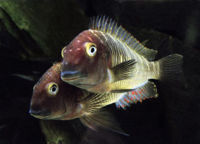Blunt-Head Cichlid (Tropheus moorii)
From The Aquarium Wiki
Blunt-Head Cichlid
Tropheus moorii
284 Litres (75 US G.)
14-15 cm (5.5-5.9")
Freshwater
8.0 - 9.0
24 -26 °C (75.2-78.8°F)
10-25 °d
1:2-5 M:F
5-8 years
Family
Cichlidae
This animal is available captive bred
Contents
Additional names
- Blunthead Cichlid, Blunt-Head Cichlid
Additional scientific names
- Tropheus moorei, Tropheus moorei moorei, Tropheus moori, Tropheus moorii moorii, Tropheus morrei
Origin[edit]
- Endemic to Lake Tanganyika, where - like other members of its genus - it occurs in numerous color forms depending on the location. The color forms should not be mixed for fear of cross breeding.
Sexing[edit]
- Monomorphic fish that are difficult to sex unless the female is holding (they are maternal mouthbrooders). However, males will be more aggressive.
Tank compatibility[edit]
- Need to be kept in groups with at least 12 and preferably 15 or more fish with more females than males, but once this is done and you have a 75 gallon tank even most shell dwellers will be safe with Tropheus assuming feeding is not an issue. However, since Tropheus have very specific dietary needs, they are best kept with other vegetarian species, such as eretmodus or even mbuna if the tank is particularly large.
- These fish are quite aggressive to their own kind, and if the minimum twelve fish are not kept the dominant individual (usually a male) will destroy all other tropheus in the tank or at least stress them out enough to make them contract bloat, which itself may kill all the other Tropheus in the tank.
Diet[edit]
- Strictly vegetarian fish that must be fed a diet consisting mostly of plant matter. Failure to feed them adequate amounts of roughage can lead to bloat, which is an infamous Tropheus killer. Note that changing their diet too quickly can also trigger bloat, so try to bring home some of the food the retailer uses to feed the Tropheus so as to gradually wean them over to a new food.
Feeding regime[edit]
- Must be fed small amounts three or four times a day to minimize aggression. "Small amounts" is key here, since overfeeding is another surefire way to give the fish bloat.
Environment specifics[edit]
- Requires hard water and a PH of about 8, as well as very few things that could possibly stress the fish. Consistency is extremely important with these fish: they need a consistent feeding schedule with the same foods, consistent, large water changes (they are sensitive to ammonia and its deriatives) at the same time and amount each week, and likewise be very consistent with other fish maintenance schedules. The sheer number of Tropheus that need to be kept means that heavy overfiltration should be considered mandatory.
Behaviour[edit]
- A mouthbrooding cichlid with interesting behavior in the wild. In the wild, males hold territories several meters in diameter on algae strewn rocks which they try to lure females to stay in. If a female consents, she spends the next month feeding voraciously on said algae: during this time, the female's ovaries ripen, and only at the end of the 1 month period - during which the male does not try to attract any more females - do the fish mate. Sadly, the tank is not large enough for this behavior to transfer over to captive life, so Tropheus tend to act a lot like Mbuna in the aquarium.
- These fish are ravenous eaters. If any fish are not being enthusiastic eaters, they more likely than not have bloat, and the tank must be treated for bloat immediately to prevent heavy fish losses. It is of utmost importance to have medicine for bloat - specifically metronidazole - before you get the fish, as they may have or get bloat when they are purchased. It is often a good idea to give the fish food soaked in metronidazole the first few days after they are purchased.
Identification[edit]
- Tropheus are beautiful, robust Tanganyikan cichlids that are not advised for beginners. They look similar to mbuna, with somewhat rounded bodies and large heads, but have something of an 'old man' look to them, and come in an extremely wide variety of colors.
Pictures[edit]
External links[edit]
- Fishbase (Mirrors:
 )
)



